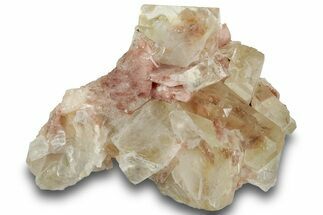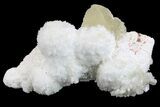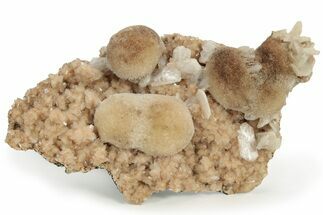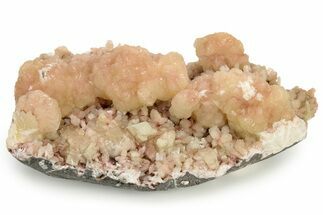This Specimen has been sold.
3.6" Stilbite, Calcite & Apophyllite Crystals on Mordenite - India
This specimen contains stilbite and calcite crystals on a micro stilbite and apophyllite encrusted, mordenite matrix. The micro-crystals sparkle when rotated underneath a light source. It was collected near Sillod Village in Maharashtra, India. It comes with an acrylic display stand.
Stilbite is a tectosilicate mineral of the zeolite group that is commonly found in zeolite deposits. Crystals often form flowery bowtie or hourglass-shaped structures and come in a variety of colors. Some of the most beautiful colorations are the pink or peach tints.
This specimen comes from the Deccan Traps, a large igneous province and one of the largest volcanic features on Earth, in the Pune Province of western India. In the course of quarrying for other materials or digging wells, sometimes large pockets of zeolites and other minerals are unearthed in the volcanic rock.
Apophyllite, while not a zeolite itself, is almost always found associated with zeolites in the same pockets. It has two crystal habits: a rectangular prism capped by a steep four-sided pyramid, or a pseudo-cubic structure. While not a well-known mineral to the general public, it is popular among mineral collectors due to its pastel colors and beautiful crystal formations.
Apophyllite, while not a zeolite itself, is almost always found associated with zeolites in the same pockets. It has two crystal habits: a rectangular prism capped by a steep four-sided pyramid, or a pseudo-cubic structure. While not a well-known mineral to the general public, it is popular among mineral collectors due to its pastel colors and beautiful crystal formations.
About Calcite Crystals
Calcite crystals are a form of calcium carbonate (CaCO₃) known for their diverse shapes, transparency, and vibrant range of colors. They typically form in rhombohedral, scalenohedral, or prismatic shapes, often with well-defined, sharp edges and glossy surfaces. Calcite crystals are often translucent or transparent, sometimes displaying a double refraction effect where objects viewed through the crystal appear doubled. They can appear in various colors—white, clear, yellow, pink, blue, green, and orange—depending on impurities or trace minerals.
A notable characteristic of calcite is its reaction with weak acids like vinegar, which causes it to effervesce, or fizz, as it releases carbon dioxide. This property makes calcite crystals a key tool in geological identification and studies. Calcite forms in many environments, from sedimentary rocks like limestone and marble to hydrothermal veins.
Calcite crystals are a form of calcium carbonate (CaCO₃) known for their diverse shapes, transparency, and vibrant range of colors. They typically form in rhombohedral, scalenohedral, or prismatic shapes, often with well-defined, sharp edges and glossy surfaces. Calcite crystals are often translucent or transparent, sometimes displaying a double refraction effect where objects viewed through the crystal appear doubled. They can appear in various colors—white, clear, yellow, pink, blue, green, and orange—depending on impurities or trace minerals.
A notable characteristic of calcite is its reaction with weak acids like vinegar, which causes it to effervesce, or fizz, as it releases carbon dioxide. This property makes calcite crystals a key tool in geological identification and studies. Calcite forms in many environments, from sedimentary rocks like limestone and marble to hydrothermal veins.
SPECIES
Stilbite, Calcite, Apophyllite & Mordenite
LOCATION
Sillod Village, Aurangabad, Maharashtra, India
SIZE
3.6 x 2.1"
CATEGORY
ITEM
#168748
 Reviews
Reviews













